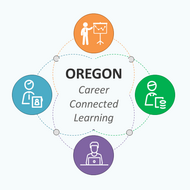
(View Complete Item Description)
Educational consortiums pool their resources and work together to achieve common objectives. These consortiums have to carefully plan and communicate to ensure that all members benefit through the shared work. For example, smaller members may have access to additional resources but often volunteer to innovate and pilot projects that contribute to the shared knowledge base. It is this delicate balance of preserving member parity that prepares a well-functioning consortium to also keep equitable practices at the center of their work, for the students we ultimately serve as well as their represented districts and other partners. This handbook is the result of over four decades of leadership by CTE Directors representing districts in eastern Oregon and the facilitation of four Regional Coordinators housed by the InterMountain Education Service District. Although much of the operational information is specific to this region and career and technical education, we share it here as one example of how a group of people representing different communities of all sizes and demographics can come together through strategic planning to identify who is being underserved, in what ways, and how regional partners can work together to serve each and every student.
Material Type:
Primary Source,
Reading
Author:
Jennifer Pambrun














